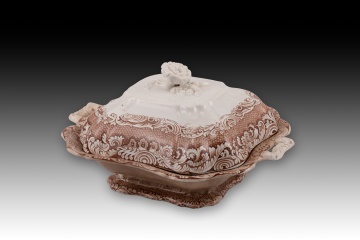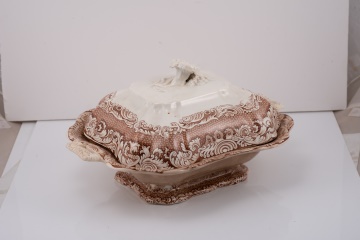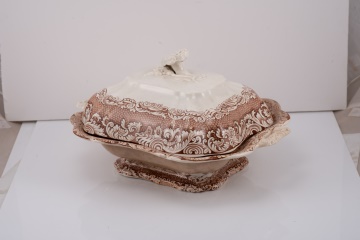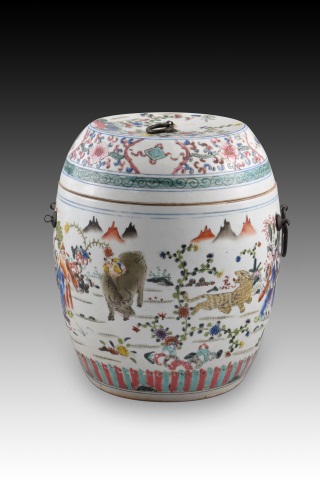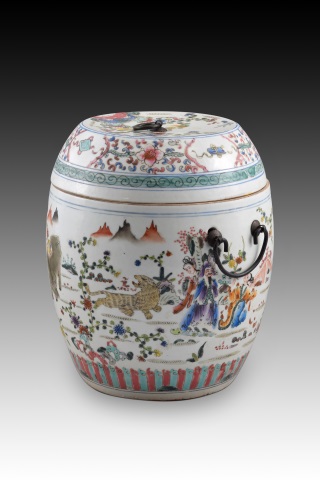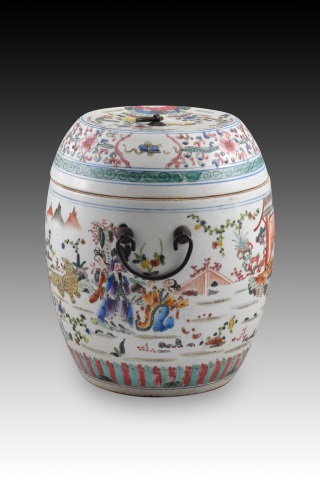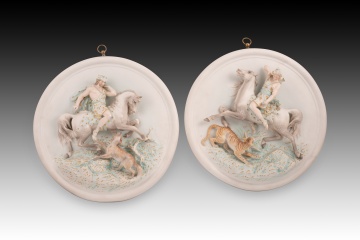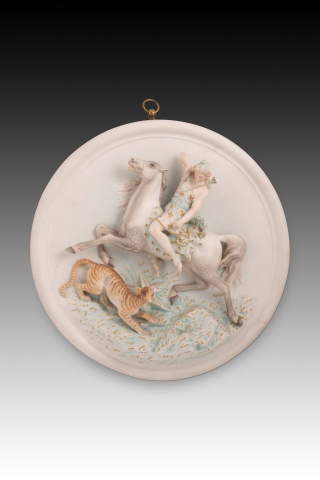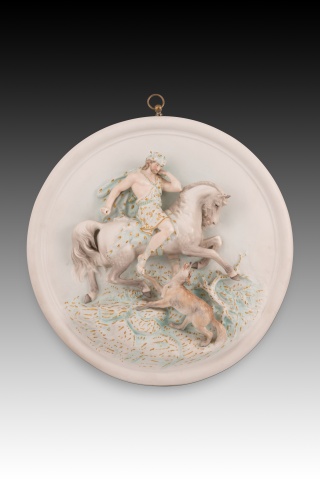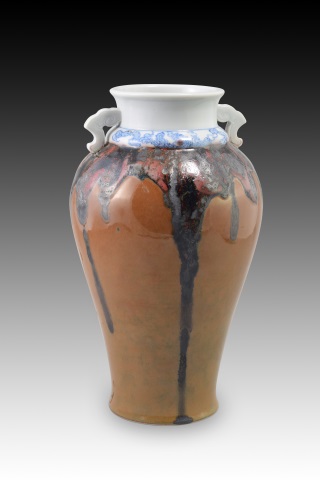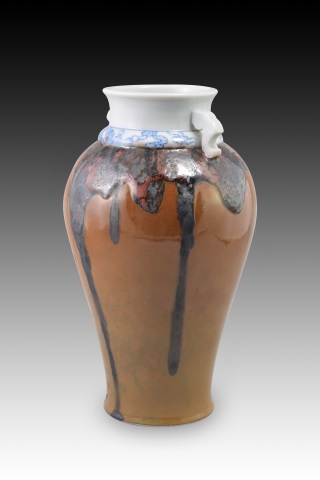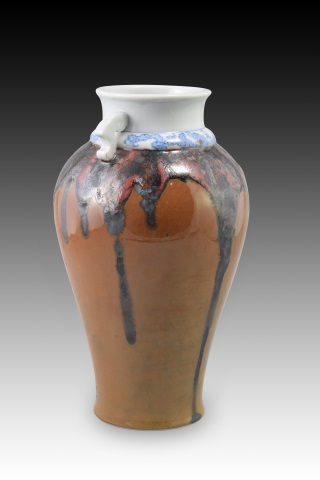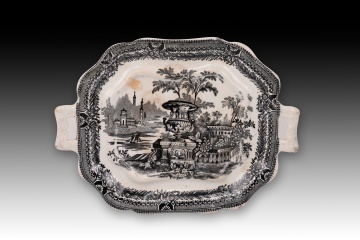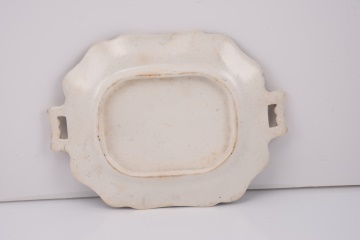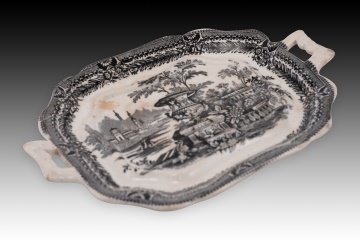
Results 1 to 22 of 22
«« « 1 » »»
-
PAIR OF BOHEMIAN CRANBERRY RUBY RED GLASS ENAMELED AND GOLD URNS. 19TH...
Pair of vases. Glass. Bohemia, Czech Republic, 19th century. Pair of red glass vases decorated with areas of white enamel and spaces in gold, highlighting the two female busts (practically portraits on an undefined background) that both pieces present on their fronts. The two raised handles finished in a circle have a fine decoration of simplified plant elements; the glass shows decoration of the same type, but of a different influence (more classicist); the busts have been enhanced by two frames in gold and dark lines clearly reminiscent of classicism; the white areas (with plant shapes) have gold lines. Both pieces show remarkable similarities in the quality of the colour of the glass and the decoration as well as in the lines of the pieces, with notable red Bohemian glass urns, especially with works linked to Ludwig Moser & Söhne. Moser is a company that manufactures luxury glass objects located in Karlovy Vary (Czech Republic; formerly Karlsbad in Bohemia) that continues its work today (it was founded in 1857 by Ludwig Moser), and is highly appreciated in the art world for its works from the late 19th and 20th centuries. Although Bohemia was a region known for its glass production as early as the 13th century (especially when they discovered that adding potassium created a clearer and more stable colourless glass than Italian glass), this activity became popular in the 17th century (although the term “Bohemian” or similar had been used for a hundred years before to distinguish quality glass from this origin), and it stood out especially in the 19th and 20th centuries thanks to important manufacturers for the quality of their materials and techniques and the care taken in their designs. By the mid-19th century they already had a system for teaching glassmaking, and in the second half they exported very striking pieces in large quantities (usually pairs of glasses or vases in a single colour in opaque glass or in two colours, decorated with enamelled floral elements, painted details; sometimes lithographic techniques were used to copy famous paintings and capture them in works; etc.) created in large factories and in large quantities.ANTIQUES
· Size: 15x13x41 cms.
Ref.: ZE222 -
CERAMIC BOWL. TALAVERA. 17-18TH CENTURIES
Bowl, Talavera, late 17th – early 18th century. Glazed ceramic. Ceramic bowl decorated with high-temperature glazes on an opaque white tin slip. The polychromy is based on typical Talavera colours: cobalt blue, copper green, manganese black, antimony yellow and iron ochres, browns and oranges. These glazes were applied to the raw slip, so the piece was fired only twice: once for the paste and once for the slip and glazes. In addition, the colours were protected with a varnish, which was also fired in this second firing. The pieces were placed in the kiln in blankets or boxes, so that the colours would not burn (they are fired at a very high temperature, 900º). In general, those from Talavera will be well fired, without significant defects. The peak of this ceramic manufacture will take place between the 16th century and the mid-18th century, when the French taste was introduced to Spain, and the clientele began to prefer pieces from Alcora. However, Talavera would experience a new Golden Age at the end of the 19th century, with historicism. This piece features a typical Talavera decoration, which would be widely imitated in other centres throughout the Modern Age: a rampant animal in the centre, on a schematic ground plane, flanked by two large plant elements. The decoration is completed with synthesised plant elements and bands of concentric lines, inside and out.ANTIQUES
· Size: 32x32x15 cms.
MISCELLANEOUS;CERAMICRef.: Z5575 -
CERAMIC DRUG JAR OR SYRUP JAR. POSSIBLY ITALY, 18TH CENTURY.
Orza. Ceramic. Possibly Italy, 18th century. A globular jug with a small base, a narrow spout at the mouth (narrower than the body, and with a small neck) and a handle formed by a twisted flat element, made of glazed ceramic and decorated with a composition in blue on a white background. Around a cartouche with an inscription (“AQa di MALVA”, alluding to a remedy derived from the common mallow, a common plant in Europe that was already mentioned, along with its healing properties, by Pliny the Elder among others), and using various shades of blue, a significant variety of plant elements and flowers have been arranged, accompanied by a bird perched on the cartouche. The decoration of ceramics in blue tones on a white background was common in Europe as early as the 17th century (Dutch and English pieces, works in Talavera de la Reina in Spain, etc.). In the case of Italy and in ceramics (with this origin, usually called “maiolica”), cobalt blue decoration on white is already found in works inspired by Byzantine in the Quattrocento, accompanying various influences. In the first third of the 16th century this “porcelain” decoration (since, apparently, it was distantly inspired by Chinese porcelain works that used these colours) continued, with touches of other colours. Compare this work with the pieces known as “Medici Porcelain”, from the third quarter of the 16th century. The name “berrettina” refers to glazed majolica in light blue to dark blue, obtained with cobalt oxide. It was used from the 16th century to the first half of the 17th century, mainly in Liguria and Veneto. It is also worth mentioning a series of pieces with which this one has something more closely related: a pharmacy jar with Saint Paul (made in Savona in the 17th century, now in the International Museum of Ceramics in Faenza), or with albarelos preserved in the Museum of Hispanic Pharmacy at the Complutense University of Madrid, works from the Italian region of Savona, pieces in private collections, etc.ANTIQUES
· Size: 24x30x26 cms.
Ref.: ZE205 -
CUP COOLER. WITH MARKS. “SOFT PASTE”. “REAL FÁBRICA DE PORCELANA DEL B...
Cooler or glass cooler. With marks on the base. White paste. Royal Porcelain Factory of Buen Retiro (Madrid, Spain), circa 1784-1803. A piece of soft paste with wavy edges used to hold the stems of glasses in place and cool them when filling the container with ice or similar. On the outside, it has two handles in the shape of plant elements and small reliefs on the fronts (also enhanced by gilding) which frame floral bouquets with coloured leaves. It is possible that the piece belongs to the second period or intermediate stage of the Royal Porcelain Factory of Buen Retiro in Madrid, established in the Spanish capital from 1760 onwards and thanks to Charles III; this stage corresponds to the “controls” of Charles Scheppers and Philip Gricci, and continues the Italian influence, adding a relationship with other currents (English, Saxon). Weight: 2225 grsANTIQUES
· Size: 33x19x13 cms.
Ref.: ZF0431 -
PORCELAIN BOX. POTSCHAPPEL-DRESDEN, GERMANY, 19TH.
Box. Enameled porcelain. Potschappel-Dresden, Germany, 19th century. With mark on the base. Rectangular box with a slightly curved lid made of enamelled porcelain with gold metal trim and hinges. The box features a decoration on the outside of figurative scenes of couples in natural landscapes with a clear Rococo feel, enhanced by gold frames and scale elements in pink tones. On the inside, on the lid, another scene of this type appears. The base of the piece bears a mark alluding to the factory responsible for it. In 1872, Carl Thieme (Carl Johann Gottlieb Thieme) converted his porcelain painting business into a porcelain factory, keeping the headquarters in Dresden and calling it Sächische Porzellanfabrik zu Potschappel (Dresden) von Carl Thieme. A mark such as the one seen on this piece was used there between 1888 and the beginning of the 20th century.ANTIQUES
· Size: 12x8x7 cms
Ref.: ZF0702 -
PAIR OF PORCELAIN VASES.19TH CENTURY.
Pair of vases. Enameled porcelain. 19th century. Pair of circular vases with a cylindrical body in the centre and a long neck and mouth open towards the outside, decorated with bands in pink tones, gold edges, grouped flowers and two genre scenes (humble characters dancing in rural landscapes; on the other side, similar scenes). They have been presented placed on metal feet, decorated with openwork elements and with claw-shaped legs finished with vegetal elements of classicist influence. They have marks on the base.ANTIQUES
· Size: 24x24x62 cms
Ref.: ZF0884 -
CERAMIC JAR. 18TH CENTURY
Jug from Villafeliche, Aragon, 18th century. Glazed ceramic. Late Baroque style jug made of ceramic and decorated with high-temperature enamels on a white tin slip. These enamelled motifs are combined with mould-made relief decorations. The typology of the piece combines the Italian jug, with an ovoid belly and vertically arched handle, with that of the typically Spanish spouted jug, characterised by the protruding spout that starts from the mouth. The decorations reveal an oriental influence, with large floral bouquets arranged asymmetrically and complex landscapes with architecture and palm trees, in which some figures are removed, these now totally western. The motifs appear brushed in manganese black, and coloured with mainly ochre, blue, green and red enamels. Aragonese pottery from the 17th to the 19th century was characterised by a strong personality, combined with the influences of Talavera and Catalonia. It had three main centres: Teruel, Muel and Villafeliche, the first two with a tradition dating back to the 16th century, and the third created at the end of the 17th century. The pottery from Villafeliche was generally very popular, although pieces of greater quality and complexity, both typological and ornamental, were also made in the 18th century.ANTIQUES
· Size: 25x18x42 cms.
MISCELLANEOUS;CERAMICRef.: Z2627 -
LOVERS WITH CAGE. PORCELAIN.
Courtiers and cage. Enameled porcelain. Johann Joachim model. Circa 1800 Enameled porcelain figure with a base resembling rocks and a pair of lovers dressed in 18th century style, with the boy reaching out his left hand towards a large birdcage. The piece is very similar to some figures entitled “Lovers with a Cage” made by Du Paquier (who opened a porcelain factory in Vienna in 1719) in 1737 and of which there are preserved examples in the Metropolitan Museum of New York or the Indianapolis Museum of Art. In turn, Du Paquier took his inspiration from works made in Meissen thanks to Johan Joachim Kaendler around 1736-1740 (varying in details such as the substitution of the table that the German ones have for the cage of the Viennese ones in some examples, or colours, for example). If the present work is compared with the works of Du Paquier, notable similarities can be appreciated in poses, elements, etc., but also important differences (colouring, details, base of the figure...).ANTIQUES
· Size: 14x12x13 cms.
Ref.: ZF0445 -
GLASS VASE. AFTER MODELS FROM ÉMILE GALLÉ.
Vase. Glass. Following models by Émile Gallé (Nancy, 1846-1904). Vase made of glass, with white, brown and gold tones, following both in technique and decoration the well-known Art Nouveau works of Émille Gallé, an artist internationally recognized both for his aesthetics and for his technical advances with glass ("enamel", "cameo", etc.).ANTIQUES
· Size: 15x15x28 cms.
MISCELLANEOUS;CERAMICRef.: Z5671 -
CERAMIC INKWELL. 18TH CENTURY
Talavera inkwell, 18th century. Glazed ceramic. Talavera ceramic inkwell, decorated with cobalt blue enamel on a white tin slip With restorationsANTIQUES
· Size: 16x16x7 cms.
MISCELLANEOUS;CERAMICRef.: Z5695 -
CERAMIC INKWELL. TALAVERA DE LA REINA, SPAIN, 17TH CENTURY.
Inkwell. Glazed ceramic. Talavera de la Reina, Spain, 17th century. A square-shaped inkwell or spice rack made of glazed ceramic with a polychrome decoration of plant elements on the top and fronts. Due to the colours used, it belongs to the so-called tricolour series, which began to be produced in Talavera de la Reina at the beginning of the 16th century and became common even at the beginning of the 18th century. Compare this with the decorations on pieces kept in the Museo Nacional de Artes Decorativas (Madrid, Spain), or in the Museo de Cerámica Ruiz de Luna in Talavera de la Reina (Toledo, Spain).ANTIQUES
· Size: 9x9x5.5 cms
Ref.: ZF1047 -
CERAMIC LEGUME BOWL, CUBA VIEW. SARGADELOS, SPAIN, 19TH CENTURY
Vegetable bowl with lid, Morro Castle, Havana, Cuba. Earthenware. Sargadelos, 19th century. It has minor flaws. Vegetable bowl with handles and a lid on which a landscape can be seen, identified with a text (Morro Castle, Havana, Cuba), enhanced by a border that extends over the edge and continues (but in relief, not in pigmentation) along the handles of the piece; the base also has decoration. The lid has a flower in relief as a finish and a series of decorative borders in a tone matching the rest of the piece. Antonio Raimundo Ibáñez, Marquis of Sargadelos, founded the Royal Pottery Factory of Sargadelos in Cervo, province of Lugo, at the beginning of the 19th century. The view of this piece belongs to the Series of Views of Cuba, used in the factory since 1848.ANTIQUES
· Size: 34x26x18 cms
Ref.: ZF1370A -
BARREL SHAPED VASE. PORCELAIN, METAL. CHINA, 20TH CENTURY.
Oriental barrel-shaped vessel. Porcelain, metal. China, 20th century. With marks on the base (apocryphal, Xangxi). A barrel-shaped vessel with a flat lid, made of white-ground porcelain and decorated with a polychrome figurative composition based on plant motifs and scrolls on the lid, and upper-class figures set in a garden with pavilions, a large censer, a tiger and other animals, etc., on the body, on a frieze of repeated elements and under a double blue line at the top (this last detail also separates the stripes on the lid). Morphologically, it is reminiscent of the Chinese porcelain seats often used in gardens, but note that it has a lid with a metal washer and handles of the same material, elements that are not found on the known seating pieces. Next to these courtiers in the pavilion is a male figure on a water buffalo (a frequent motif in Chinese art, associated with either wise men or peasants or shepherds). The marks on the base, located within a double circular line, resemble those used on Chinese porcelain made during the Kangxi Empire (1662-1722), but are considered apocryphal.ANTIQUES
· Size: 25x25x30 cms.
Ref.: ZF1082 -
GLAZED CERAMIC SPICE CONTAINER. TALAVERA DE LA REINA, SPAIN, 18TH CENT...
Spice rack in glazed ceramic. Talavera de la Reina, 18th century. A three-cup spice rack in the shape of an equilateral triangle, made of ceramic and decorated with high-temperature enamels typical of Talavera polychromy: manganese black for the edges and antimony oranges and yellows, copper green and cobalt blue. It is a classic-style piece, with clean lines that delimit the different parts of the structure, well-organised decoration and synthetic motifs that refer to the Greco-Latin ornamental repertoire, such as the palmette and the acanthus leaf.ANTIQUES
· Size: 16x14x4,5 cms.
Ref.: ZF1255 -
HUNTERS, PAIR OF PLAQUES. PORCELAIN.
Hunters, pair of panels. Porcelain. Possibly Germany, 19th century. Pair of wall plaques with metal pieces to hang on the top and a polychrome figurative decoration on the front, in relief. One shows a horseman dressed in furs, accompanied by a fox (probably), and the other shows a woman, also on horseback, hunting a feline (possibly a tiger). Their style is reminiscent of porcelain pieces made in Meissen in the 19th century.ANTIQUES
· Size: 31x31x6 cms
Ref.: ZF1387 -
PORCELAIN CENTREPIECE. EUROPE, CA END 19TH CENTURY.
Table centrepiece. Europe, towards the end of the 19th century. Glazed porcelain. Enameled porcelain piece with gold details that allows flowers to be placed inside. It has a cube shape, with the handle decorated with rocailles inspired by the Rococo of the 18th century, also present on the edge of the piece and at the bottom. The fronts have been decorated with a series of flowers in various colours. It has a mark on the base, blue on a white background.ANTIQUES
· Size: 15x15x29 cms.
Ref.: ZF0146 -
POSEIDON OR NEPTUNE. PORCELAIN. EUROPE, 19TH CENTURY.
Poseidon or Neptune with a hippocampus. Enameled porcelain. Europe, 19th century. A glazed porcelain figurine with a circular base, decorated with openwork elements and Rococo-inspired motifs enhanced with touches of gold, depicting a bearded, half-naked male figure, standing, in a purple and white cloak, accompanied by a half-horse, half-fish monster. The character is the classical god Poseidon or Neptune, and the creature is known as a hippocampus. This type of work was common in several prominent porcelain factories throughout the 19th century, especially Meissen, but also Chelsea (whose brand name is an anchor) or Samson, for example.ANTIQUES
· Size: 6x7x15 cms.
Ref.: ZF0995 -
BALUSTER VASE. PORCELAIN. TAISHO ERA, JAPAN, 1912-1026.
Baluster vase. Porcelain. Taisho period, Japan, 1912-1926. With marks on the base. Baluster vase (due to its shape) made of brown glazed Hirado porcelain with iron oxide varnish and two sceptre-shaped handles on top. Hirado is a type of porcelain made mainly in Mikawachi, Sasebo and Nagasaki, in the former feudal territory of Hirado, owner of the kilns and responsible for production. The Taisho period was that under the government of the emperor of the same name, and lasted from July 30, 1912 to December 25, 1926.ANTIQUES
· Size: 15x15x27 cms.
Ref.: ZF1109 -
CERAMIC SPICES RECIPIENT. TALAVERA DE LA REINA, SPAIN, 17TH CENTURY.
Triangular spice rack. Glazed ceramic. Talavera de la Reina, Spain, 17th century. It has damage. Triangular spice rack made of glazed ceramic decorated with a relief element in the centre of the three fronts and a series of motifs painted in brown, yellow and green on the top and on these fronts. Typologically, this is a very common model in the workshops of Talavera de la Reina, although not exclusive to this centre.ANTIQUES
· Size: 14x13x5 cms.
Ref.: ZF0940 -
COFFEE SET. PORCELAIN. ROYAL VIENNA, AUSTRIA, EARLY 20TH CENTURY.
Coffee set. Enameled porcelain. Royal Vienna, Austria, early 20th century. With marks on the base of the pieces. Two cups broken. Enameled porcelain coffee set consisting of a tray, six cups and saucers, a sugar bowl with lid and a jug with lid. Although the classicist influence in the piece is clear (golden garlands, shapes, plant elements, colours, etc.), it is necessary to point out that the tray was inspired by the oil painting by George Sheridan Knowles in 1908 and entitled “Summer Pleasures on The River”. Royal Vienna is a certain style of porcelain related to the porcelain made in Vienna (Kaiserlich privilegierte Porcellain Fabrique) founded in 1718 by Claude du Paquier, an official of the imperial court in Vienna. It was closed in 1864, but its name was recovered by the Vienna Porcelain Factory Augarten in 1923.ANTIQUES
· Size: 32x32x15 cms.
Ref.: ZF1147 -
AIR ALLEGORY. PORCELAIN. PORCELANA HISPANIA, SPAIN, 20TH CENTURY.
Allegory of Air. Enameled porcelain. Hispania porcelain, Spain, 20th century. Enameled porcelain figure with gold touches showing a half-naked child, with an old-style hot air balloon and bellows, sitting on a base clearly reminiscent of the Rococo era on which the text “El Aire” can be read, alluding to the allegory that the piece represents. This type of work is inspired by outstanding works from European factories. The factory known as Porcelana Hispania made a series of quality pieces in this same line (animals, couples with a Rococo influence, etc.).ANTIQUES
· Size: 12x8x15 cms.
Ref.: ZF0992 -
CERAMIC TRAY, SERIE GÓNDOLA. SARGADELOS, 19TH CENTURY.
Tray, Gondola Series. Crockery. Sargadelos, Third period (1845-1862). With brand. Rectangular tray with handles decorated with a border with plant and architectural elements and a landscape in the background. The piece is reminiscent of those in the series known as “de la góndola” (because this element appears in that landscape) from the third Sargadelos Factory period (1845-1862). Partially stamped with a mark on the base.ANTIQUES
· Size: 22x16x2,5 cms
Ref.: ZF1370B
«« « 1 » »»
Results 1 to 22 of 22




































